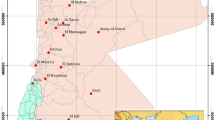Abstract
Hydrochemical investigations in the Kalambaina Formation have been initiated to determine potability and suitability of the shallow groundwater for domestic and agricultural uses. This limestone formation is an extensive aquifer supplying water to livestock and domestic wells in its outcrop areas. The aquifer is recharged by rainfall and discharges mainly into the Sokoto–Rima River system and lakes at Kware, Gwadabawa and Kalmalo in Nigeria. Because recharge to the aquifer is mainly from rainfall, the quality of the groundwater is controlled essentially by chemical processes in the vadose zone and locally by human activities. Water samples were taken at 11 sites comprising boreholes, dug wells and a spring and were chemically analysed for their major ion components. Hydrochemical results show water of fairly good quality. It is, however, hard and generally of moderate dissolved solids content. Concentration of the total dissolved solids is between 130 and 2,340 mg/l. Concentrations of ions vary widely but a high concentration of K+ is found in places. NO −3 is on the higher side of the World Health Organization (WHO) permissible limits, indicating pollution in such areas. Groundwater chemistry is predominantly of two facies, namely the calcium–magnesium–bicarbonate and calcium–magnesium–sulphate–chloride facies. These facies probably evolved primarily as a result of dissolution of calcium and magnesium carbonates as well as some human/land-use activities.



Similar content being viewed by others

References
Anderson HR, Ogilbee W (1973) Aquifers in the Sokoto Basin, northwestern Nigeria, with a description of the general hydrogeology of the region. U.S. Geological Survey Water Supply Paper 1757–L:79
APHA (American Public Health Association) (1971) Standard methods for the examination of water and wastewater. APHA, New York
Born SM, Yanggen DA, Zaporozec A (1987) A guide to groundwater quality planning and management for Local Governments. Wisconsin Geological and Natural History Survey, Madison, Special Report 9:91
Chebotarev IJ (1955) Metamorphism of natural waters in the crust of weathering. Geochim Cosmochim Acta 8:22–212
Davis SN, De Wiest RJM (1966) Hydrogeology. Wiley, New York
Freeze RA, Cherry JA (1979) Groundwater. Prentice-Hall, Englewood Cliffs
Gustafson DI (1993) Pesticides in drinking water. Van Nostrand Reinhold, New York
JICA (Japan International Cooperation Agency) (1990) The study of groundwater development in Sokoto State, vol. 2, main report. JICA, Lagos
Kogbe CA (1979) Geology of the south-eastern (Sokoto) sector of the Iullemmeden Basin. Bulletin 1, vol. 2. Department of Geology, Ahmadu Bello University, 420 pp
Kowal JM, Knabe DT (1972) An agroclimatological atlas of the northern states of Nigeria. Ahmadu Bello University, Zaria, Nigeria, 111 pp
Niger-Techno Ltd (1978) Pre-drilling hydrogeological investigations, Area II-Final Design, NIGER-TECHNO Ltd, Lagos, 113 pp
Oteze GE (1976) The hydrogeology of the northwestern Nigeria basin. In: Kogbe CA (ed) Geology of Nigeria. Elizabethan Publishing Co., Ibadan, Nigeria, pp 455–472
Petters SW (1978) Foraminiferal paleoecology of the southeastern part of the Maastrichtian-Paleocene Saharan Epeiric Sea. J Foraminiferal Res 8(4):303–313
Piper AM (1944) A graphic procedure in geochemical interpretation of water analysis. Trans Am Geophys Union 25:914–923
Raji BA (1996) Pedogenesis of ancient dune soils in the Sokoto Sedimentary Basin, northwestern Nigeria. PhD thesis, Ahmadu Bello University, Zaria, 194 pp
Tauer W, Humborg G (1992) Runoff irrigation in the Sahel zone: remote sensing and geographical information system for determining potential sites. Technical Centre for Agricultural and Rural Cooperation, ACP-EEC, 192 pp
U.S. Salinity Laboratory Staff (1954) Diagnosis and improvement of saline and alkali soils. Agriculture handbook. U.S. Department of Agriculture, Washington
WHO (World Health Organisation) (1984) Guidelines for drinking water quality, vol. 1, recommendations. WHO, Geneva
Acknowledgements
This paper is a preliminary result of a research work supported in part by grant from the University Board of Research, Ahmadu Bello University, Zaria, Nigeria. The financial assistance is gratefully acknowledged.
Author information
Authors and Affiliations
Corresponding author
Rights and permissions
About this article
Cite this article
Alagbe, S.A. Preliminary evaluation of hydrochemistry of the Kalambaina Formation, Sokoto Basin, Nigeria. Environ Geol 51, 39–45 (2006). https://doi.org/10.1007/s00254-006-0302-5
Received:
Accepted:
Published:
Issue Date:
DOI: https://doi.org/10.1007/s00254-006-0302-5



